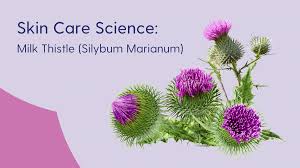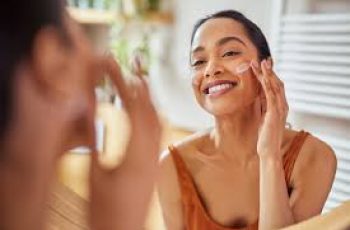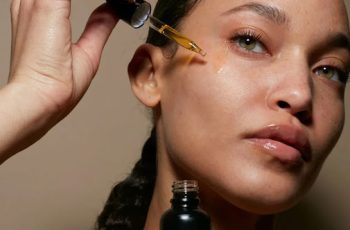The Science of Milk Thistle Extract in Skin Care
Milk thistle (Silybum marianum) is a rising star in skin care, and not just because it’s pretty. This botanical beauty has a variety of skin benefits to offer, including anti-aging, anti-inflammatory, and antioxidant properties. While this ingredient is generally well-tolerated by most skin types, milk thistle is most often included in formulations with other ingredients, so make sure any milk thistle product you are using is right for your Baumann Skin Type.
Milk thistle is a great skin care ingredient for anti-aging and soothing inflammation.
It can offer added protection against sun damage and oxidative stress.
Don’t use it if you are allergic to other plants in the same family, like ragweed, daisies, or marigolds.
What Is Silybum Marianum?
Milk thistle, also known as Silybum marianum, is a flowering herb related to the daisy and ragweed family. It is native to Mediterranean countries but is now found throughout the world. Historically, milk thistle has been used for its medicinal properties, primarily for liver health. The seeds and leaves contain a group of compounds called silymarin, which have strong antioxidant and anti-inflammatory properties, making them excellent additions to many skin care products.
What Is Silymarin?
Silymarin is a group of flavonoids extracted from the seeds of the milk thistle plant. The main active compounds in silymarin are silybin, silydianin, and silychristin. Silybin, also known as silibinin, is the most potent and well-researched of these compounds. Together, these flavonoids provide powerful antioxidant, anti-inflammatory, and detoxifying effects.
How Is Silybum marianum Used in Skin Care?
Milk thistle is primarily used in skin care for its silymarin content, which is known to provide several benefits. Here are the common ways milk thistle is incorporated into skin care:
Antioxidant protection. Silymarin is a powerful antioxidant that helps protect the skin from free radicals. Free radicals can cause premature aging by damaging skin cells and breaking down collagen if left unneutralized.
Anti-inflammatory properties. Silymarin’s anti-inflammatory effects can help reduce redness and swelling, making it beneficial for conditions like acne and rosacea.
UV protection. Some studies suggest that milk thistle can help to protect the skin from UV damage, which can lead to sunburn and increase the risk of skin cancer. However, this ingredient should not be used as your sole method of sun protection – though it may offer extra protection against sun damage.
Benefits of Milk Thistle in Skin Care
Silybum marianum can provide your skin with a number of benefits. Most notably:
Anti-aging. The antioxidant properties of milk thistle can help to reduce the appearance of fine lines and wrinkles by protecting the skin from oxidative stress.
Acne treatment. Due to its anti-inflammatory properties, milk thistle can help reduce the redness and swelling associated with acne. It also helps to regulate oil production, which can help to prevent future breakouts.
Hyperpigmentation reduction. Milk thistle can help to lighten dark spots and improve hyperpigmentation. Its compounds inhibit the production of excess melanin, which causes dark spots.
Skin soothing. For those with sensitive skin, milk thistle’s soothing anti-inflammatory properties can help to calm irritation and redness.
What is Milk Thistle Made of?
Milk thistle, scientifically known as Silybum marianum, has more going for it than a “silly” name. It is a flowering plant that’s made of several interesting compounds with skin care uses. The main active ingredient in milk thistle is silymarin, a complex of flavonolignans that includes silibinin, silychristin, and silydianin. Silymarin is prized in many products for its strong antioxidant properties, which help protect skin cells from oxidative stress and damage caused by free radicals.
Silibinin, the most potent component of silymarin, is especially notable for its ability to promote collagen synthesis. It also has anti-inflammatory properties, making it effective in soothing irritated skin and reducing redness. This versatile ingredient also contains fatty acids and vitamin E, both of which contribute to its versatile effects. These components make milk thistle a valuable ingredient in skincare products able to protect, repair, and calm the skin.
Which Products Contain Silybum marianum?
Many skin care products include Silybum marianum for its anti-aging and anti-inflammatory properties. Here are a few of my favorites:
Milk Thistle Side Effects
Milk thistle is generally safe with minimal side effects when applied topically. Safety organizations such as the Environmental Working Group (EWG) have graded it as safe for use in skin care. However, if you are allergic to plants in the same family as milk thistle, such as ragweed, daisies, marigolds, or chrysanthemums, avoid using milk thistle in skin care.
The only reason not to use this ingredient would be if the product formulation wrong for your skin type.
Bottom Line: Is Silybum marianum Right For Your Skin?
Milk thistle can be a valuable addition to your skin care routine, particularly if you’re looking for natural, plant-based ingredients with proven benefits. Its antioxidant and anti-inflammatory properties can help to protect and soothe the skin, reduce signs of aging, and combat acne and hyperpigmentation. However, it is essential to choose products that are well-formulated and to be mindful of potential allergies. For personalized advice, learn your Baumann Skin Type by taking the quiz at Skintypesolutions.com to see if milk thistle is a good fit for your specific skin type.
DQH Knowledge drop: In your 20s, your skin cell turnover decreases. (Cell turnover is a key component in keeping your skin youthful.) You know what else slows down? Your collagen production. Starting in your 20s, collagen decreases by about 1 percent per year. Should you want to prevent fine lines and wrinkles, start by eliminating behaviors that contribute to premature aging. “If it’s bad for you, it’s bad for your skin,” says dermatologist Michel Somenek.
“Cigarette smoking reduces blood flow to the skin and causes premature wrinkling and a dull skin texture. Making the repeated pursed motion to inhale can also cause smoker’s lines. Alcohol and recreational drugs are toxins for the skin that damage its cellular structure and DNA,” Somenek tells us. “The faster you eliminate vices while you are young, the better chance your skin and body have to recuperate.” Also, adopting an anti-aging routine in your 20s is key. After all, the best offense is a good defense. We spoke to Somenek and experts Joshua Ross and Audrey Kunin to find out more.
Keep reading for the best anti-aging products for your 20s, according to skincare professionals.
Sunscreen
“We all know that the sun is the number one cause of skin aging and starting the prevention in your 20s is very important,” Ross says. “The majority of your sun damage won’t start to appear until you’re in your 30s, so don’t wait until you see it surface or you’ll be behind the curve. Stay ahead of it with a good-quality zinc-based sunscreen worn daily.”
Farmacy Green Defense Daily Mineral Sunscreen
An invisible sunscreen with SPF 30, plus botanical extracts meant to protect skin with tons of antioxidants. Bonus: It’s clean and fine to use under makeup.
Bareminerals Complexion Rescue™ Tinted Moisturizer Broad Spectrum SPF 30
Although we recommend you use your SPF and moisturizer separately, we also understand moments when you don’t have time or energy for that extra step. For those times, this bareMinerals moisturizer is a great thing to have on hand.
Vitamin C Serum
“A great introduction to anti-aging is to start with a vitamin C serum in your morning skincare routine,” Ross says. “It’s a powerful antioxidant that will neutralize free radicals and brighten the skin.” He adds that it’s a great way to counteract the effects of the sun’s harmful rays, which, as previously mentioned, are among the biggest causes of premature aging.
Drunk Elephant C-Firma™ Vitamin C Day Serum
The Drunk Elephant C-Firma is a lightweight serum that promises to give skin a glow by combining the brightening powers of vitamin C with ferulic acid, l-ascorbic acid, and vitamin E. The included sodium hyaluronate is meant to replace hydration loss, so you shouldn’t have to deal with any irritation.
Sunday Riley C.E.O. Rapid Flash Brightening Serum
This potent serum is jam-packed with vitamin C (15 percent, to be exact), which means it’s a potential superstar at both brightening skin and dousing it in antioxidants.
Peptides
Using peptides on your skin has many benefits, says Somenek. “The skin barrier is what defends the body against pollution, UV rays, bacteria, and toxins. It can be damaged by several everyday factors. Using topical peptides aids in building a stronger barrier,” he says. “Peptides comprise elastic fibers, which are a type of protein. These fibers help to make skin appear taut and firm. Peptides can also help repair damaged skin, relieve inflammation, and even out skin tone. Some peptides can kill acne-causing bacteria that is common in 20-somethings.”
Kunin agrees, saying, “Peptides are an excellent entry point for supporting collagen.” She recommends looking for face and eye treatments that contain these collagen-boosting powerhouses.
Charlotte Tilbury Magic Eye Rescue Cream
This Charlotte Tilbury super-emollient eye cream has a base of coconut oil and shea butter (read: it’s incredibly hydrating). Botanicals plus peptides are meant to help reduce dark circles and boost collagen, respectively.
This creamy moisturizer serves up potent collagen-boosting peptides and pycnogenol, and antioxidant-rich vitamin C. “Instead of sitting on top of the skin, peptides penetrate the outer layer so they go deep. The ‘signals’ they send tell the cells to produce elastin and collagen, which are needed for youthful-looking skin,” explains Somenek.
At-Home Peel Pads
Remember that skin cell turnover fiasco we talked about earlier? One way to help support it is by exfoliating. “Exfoliation is important to help keep skin fresh and luminous,” Kunin says. She recommends using at-home peel pads as an easy and effective way to exfoliate.
“The goal in your 20s is to fight the slowing pace of cell turnover. It is wise to use products that gently exfoliate, yet still remove oil and other impurities. Products that have Alpha Hydroxy Acids (AHA) or Beta Hydroxy Acids (BHA) are a good choice.”
According to Somenek, you should only exfoliate two to three times a week. “People of all ages are guilty of over-exfoliating and that can be too much of a good thing,” he says.
Dermadoctor Kakadu C Intensive Vitamin C Peel Pad
A few swipes of this Derma Doctor powerful peel pad promise to leave your skin glowing and smooth, thanks to the seven (yes, seven) types of chemical exfoliants, including AHA and BHA. It also contains vitamin C via Kakadu plum extract for added brightening and antioxidant protection.
KEY INGREDIENTS Kakadu plum extract is sourced from the Kakadu plum, a fruit grown in northern Australia. It contains vitamin C, which restores the skin’s natural barrier, increases collagen production, and soothes irritation.
Dr. Dennis Gross Skincare Alpha Beta® Universal Daily Peel Pads
These are the gold standard of peel pads, with a cult following and over 900 five-star reviews on Sephora. They’re easy to use and contain a blend of anti-aging exfoliating acids.
Emollient Night Cream
“In your 20s, you need to start upping the hydration in your skincare routine. You may have been cautious of over-moisturizing because of acne in your teens, but as you enter your 20s, your skin transitions and becomes drier,” Ross says. “I recommend an emollient night cream added into your evening skincare regimen.”
“Twenty-somethings need to make sure that they are not using creams that will clog their pores and cause excess oil production,” says Somenek. Opt for non-comedogenic products.
Cerave Skin Renewing Night Cream
One great choice is the CeraVe Skin Renewing Night Cream, which is a non-comedogenic night cream that leaves skin soft and glowy. It combines the moisturizing powers of ceramides and hyaluronic acid.
RoC Retinol Correxion Max Hydration Creme
“The best night cream ingredients contain retinol, benzoyl peroxide, and/or salicylic acid or hyaluronic acid. The goal is to moisturize, yet remove excess oil,” says Somenek. This Roc Retinol Correxion cream fits the bill as it contains both hyaluronic acid and retinol so it promises to moisturize while also being non-comedogenic.



